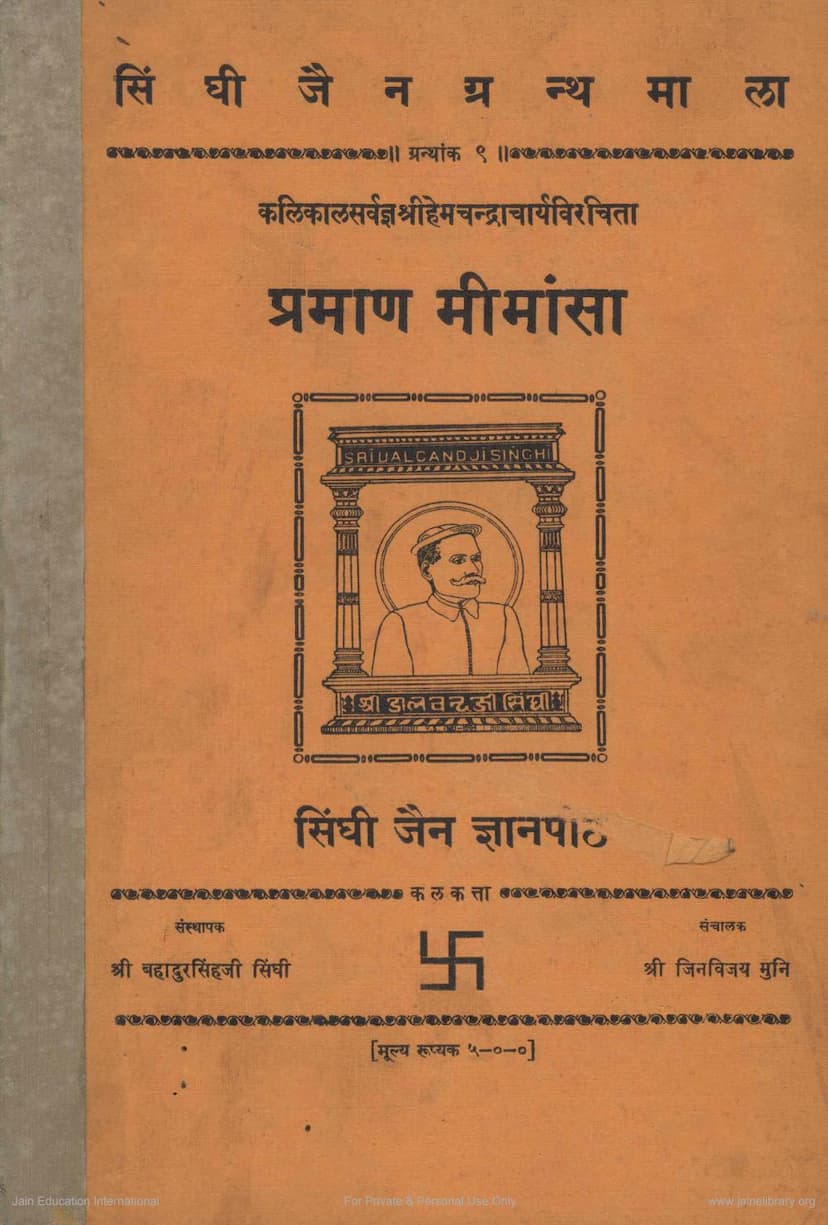Pramana Mimansa Tika Tippan
Added to library: September 2, 2025

Summary
This document is the first part of a summary of the Jain text "Pramana Mimamsa" by Acharya Hemchandracharya, along with a commentary. The summary is presented in English.
Here's a breakdown of the key aspects covered in the provided pages:
- Book Title: Pramana Mimamsa (प्रमाण मीमांसा)
- Author: Acharya Hemchandracharya (कलिकालसर्वज्ञ श्रीहेमचन्द्राचार्य)
- Commentary/Tika: Swopadnya Vritti (स्वोपज्ञवृत्ति-सहिता) which is the author's own commentary.
- Additional Commentary/Tippan: Bhasha Tippana (भाषाटिप्पण) by Pandit Sukhlal Sanghavi (पण्डित सुखलालजी संघवी).
- Editors: Pandit Sukhlal Sanghavi, Pandit Mahendrakumar Shastri, and Pandit Dalsukh Malvania.
- Publisher: Singhi Jaina Granthamala (सिंघी जैन ग्रन्थमाला)
- Founder: Shri Bahadur Singhji Singhi (श्री बहादुरसिंहजी सिंघी), in memory of his father Shri Dalchandji Singhi (श्री डालचन्दजी सिंघी).
- General Editor: Jina Vijaya Muni (श्री जिनविजय मुनि).
- Publication Details: First Edition, 1000 copies, Vikram Samvat 1995 (1939 AD).
The document also includes:
- Praise for the Publisher and Series (Pages 8-9): Detailed accounts of the Singhi family's contribution to the publication of Jain literature, highlighting their generosity and commitment to spreading Jain knowledge.
- Table of Contents (Pages 12-17): This outlines the structure of the book, including various introductory sections, the original text of Pramana Mimamsa, the Bhasha Tippana, and several appendices (Parishishth). These appendices cover a wide range of scholarly materials like textual comparisons, lists of special names, technical terms, quotations, and more.
- Introduction/Preface (Pages 17-43):
- Prefatory Remarks (Yat Kinchit Prasangik - यत्किंचित् प्रासंगिक) by Jina Vijaya Muni (Page 17): This section introduces the work and praises Pandit Sukhlal Sanghavi's contribution, highlighting the importance of the Bhasha Tippana and the comparative study of philosophical terms.
- Editorial Statement (Sampadan Vishayak Vaktavya - सम्पादन विषयक वक्तव्य) by Pandit Sukhlal Sanghavi (Pages 19-25): Pandit Sukhlal explains the genesis of this edition, the challenges faced during its preparation (including a personal illness), the critical approach to the text, the significance of the appendices, the division of labor among the editors, and expresses gratitude to all who assisted. He emphasizes the unique nature of the Bhasha Tippana in clarifying complex philosophical and comparative points between Jain, Buddhist, and Brahmanical philosophies.
- Foreword (Bhumika - भूमिका) by Mahamahopadhyay Pt. Pramathanath Tarkabhushan (Page 25): This foreword provides a critical appraisal of Hemachandracharya's Pramana Mimamsa, acknowledging its significance within Jain epistemology and its role in refuting other philosophical schools. It also praises Pandit Sukhlal's Hindi commentary for its clarity, historical perspective, and comparative analysis.
- Introduction (Prastavana - प्रस्तावना) by Pandit Sukhlal Sanghavi (Pages 26-58): This is a comprehensive scholarly introduction that delves into:
- Internal Structure (Abhyantar Swaroop - आभ्यन्तर स्वरूप): Discusses the core philosophical principles of the Jain perspective on Pramana, its immutability, the limits of perception, and the scope of knowable objects.
- External Structure (Bahya Swaroop - बाह्य स्वरूप): Covers the textual aspects, including style, division, size, and language.
- Place in Jain Logic Literature: Traces the historical development of Jain logic, from the Agam era to the Sanskrit era, highlighting the establishment of Anekanthavada and the subsequent systematic development of Jain epistemology (Pramana Shastra) culminating in Hemachandracharya's work.
- Contribution of Jain Acharyas to Indian Epistemology: Details the significant contributions, particularly Anekanthavada, Naya Vada, and Saptabhangi, and how they provided a unique framework for understanding reality.
- Hemachandracharya's Contribution: Highlights Hemachandracharya's synthesis of existing knowledge and his unique contribution to the field.
- Author's Introduction (Granthakar ka Parichay - ग्रन्थकार का परिचय) by Rasiklal Chh. Parikh (Pages 58-71): This section focuses on the life and times of Acharya Hemachandracharya, his prolific literary output, his association with the Solanki kings Jayasinh Siddharaj and Kumarpal, and his influence on Gujarati culture and Jainism.
The subsequent pages (starting from page 71 onwards) provide the index of chapters, verses, and detailed footnotes (Bhasha Tippani - भाषाटिप्पणानि) in Hindi, offering explanations, comparisons with other philosophical schools, and historical context for the original Sanskrit text.
In essence, this document is a critical edition of Hemachandracharya's Pramana Mimamsa, presented with extensive scholarly apparatus, including a detailed commentary, editorial notes, and biographical information, making it a valuable resource for understanding Jain epistemology and its place within the broader Indian philosophical landscape.